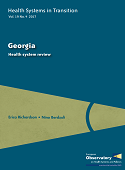Georgia HiT (2017)

Download
This analysis of the Georgian health system reviews developments in its organization and governance, health financing, health-care provision, health reforms and health system performance. Since 2012, political commitment to improving access to health care, to protecting the population from the financial risks of health-care costs and to reducing inequalities has led to the introduction of reforms to provide universal health coverage.
Considerable progress has been made. Over 90% of the resident population became entitled to a tightly defined package of state-funded benefits in 2013; previously, only 45% of the population had been eligible. The package of services has variable depth of coverage depending on the groups concerned, with the lowest income groups enjoying the most comprehensive benefits. To finance this broader coverage, the government increased health spending significantly, although it remains low in international comparisons. Out-of-pocket (OOP) payments have fallen as public spending has increased. Nevertheless, current health expenditure is still dominated by OOP payments (57% in 2015), two thirds of which are for outpatient pharmaceuticals. For this reason, in July 2017, the package of benefits was expanded for the most vulnerable households to cover essential medicines for 4 common chronic conditions.
The system has retained extensive infrastructure with strong geographical coverage. Georgia also has a large number of doctors per capita, but an acute shortage of nurses. Incentives in the system for patients and providers favour emergency and inpatient care over primary care. Also, financial incentives to improve the quality of care are limited and disincentives are lacking to inhibit poor quality of care. Future reform plans focus on ensuring universal access to high-quality medical services, strengthening primary care and public health services, and increasing financial protection.





















